Rio Tinto Bundle
Unveiling the Inner Workings of Rio Tinto: A Mining Giant?
Ever wondered how the essential materials that power our world are sourced? Rio Tinto, a global leader in the mining industry, is at the forefront of this process, extracting resources crucial for modern life. From the steel in our buildings to the copper in our electronics, the company's Rio Tinto SWOT Analysis reveals its strategic position in the global market. Understanding Rio Tinto's operations is key to grasping its impact on the global economy.
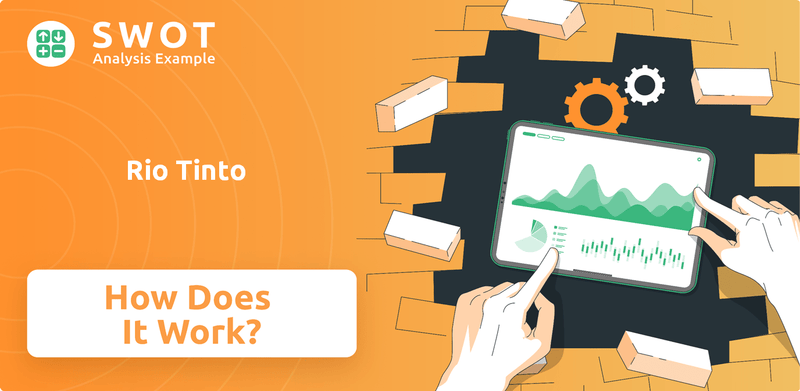
This exploration into Rio Tinto's business model will illuminate its role as a leading mining company and how it generates substantial revenue through resource extraction. We'll delve into its global mining footprint, examining its main products and strategic evolution. Furthermore, we'll analyze the challenges and opportunities facing Rio Tinto, providing a comprehensive view of its operations and future prospects.
What Are the Key Operations Driving Rio Tinto’s Success?
Rio Tinto, a leading mining company, creates value by finding, mining, and processing the Earth's mineral resources. Its core business involves the resource extraction of essential materials for a global customer base. The company's operations are vertically integrated, encompassing exploration, mine development, extraction, processing, and transportation.
The company's main products include iron ore, aluminum, copper, diamonds, and other minerals. Rio Tinto serves a diverse range of customer segments, from steel manufacturers and automotive companies to electronics producers and jewelry retailers. Strategic partnerships, such as joint ventures in specific mining projects, enhance its operational reach and share investment risks. Distribution networks are global, leveraging a combination of direct sales, long-term contracts, and participation in commodity markets.
What makes Rio Tinto operations unique is its focus on large-scale, long-life, and low-cost assets, which provides significant economies of scale and resilience to commodity price fluctuations. Its technological advancements in areas like autonomous haulage systems and remote operations centers contribute to operational efficiency and safety. These core capabilities translate into benefits for customers through reliable supply, consistent quality, and a commitment to responsible sourcing, differentiating Rio Tinto in the competitive mining landscape.
Rio Tinto extracts and processes a variety of minerals. These include iron ore, aluminum, copper, diamonds, and other minerals. These materials are essential for various industries globally, including construction, manufacturing, and technology.
The company serves a wide array of customers. These include steel manufacturers, automotive companies, electronics producers, and jewelry retailers. Rio Tinto ensures a reliable supply of high-quality materials to meet global demand.
Rio Tinto mining operations are vertically integrated. This includes exploration, mine development, extraction, processing, and transportation. For example, in iron ore, the company operates extensive infrastructure in the Pilbara region of Western Australia.
The supply chain is complex, involving extensive logistics. Raw materials are transported from remote mining sites to processing facilities and then to customers. Strategic partnerships and global distribution networks enhance efficiency.
Rio Tinto focuses on large-scale, long-life, and low-cost assets. This provides significant economies of scale and resilience to commodity price fluctuations. Technological advancements, such as autonomous haulage systems, contribute to operational efficiency and safety.
- Reliable Supply: Provides consistent and dependable material supply.
- Consistent Quality: Ensures high-quality products for customers.
- Responsible Sourcing: Commits to sustainable and ethical practices.
- Global Reach: Operates across multiple continents to serve global markets.
Rio Tinto SWOT Analysis
- Complete SWOT Breakdown
- Fully Customizable
- Editable in Excel & Word
- Professional Formatting
- Investor-Ready Format
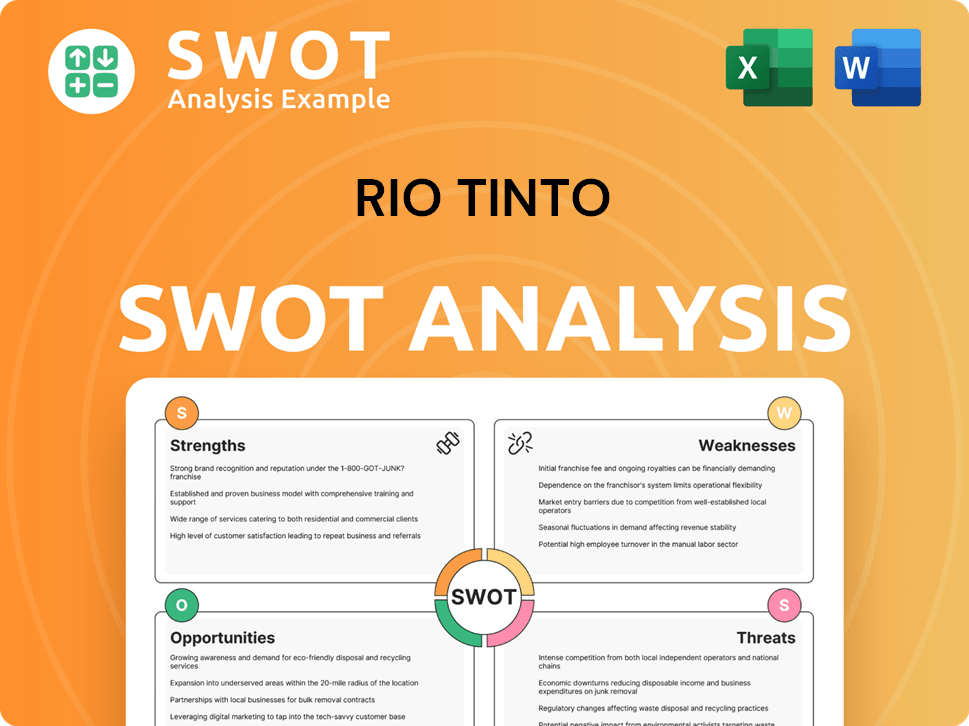
How Does Rio Tinto Make Money?
The core of Rio Tinto's financial success lies in its diverse revenue streams, primarily derived from the sale of mined commodities. This global mining company strategically manages its operations to capitalize on market dynamics and ensure sustained profitability. Key to this strategy is the efficient extraction and sale of essential resources.
The company's revenue model is built on direct sales and participation in global commodity markets. This approach allows for both stability through long-term contracts and the flexibility to respond to price fluctuations. Operational efficiency and strategic investments are crucial for maximizing margins and ensuring long-term value creation.
Rio Tinto's main revenue streams are categorized by commodity. Iron ore is a major contributor, with shipments from the Pilbara region reaching 331.8 million tonnes (100% basis) in 2024. Aluminum, sourced from bauxite mining, alumina refining, and aluminum smelting, also provides significant revenue. Copper sales are driven by global demand, and the 'Minerals' segment adds to the revenue mix.
Rio Tinto's monetization strategies are multifaceted, focusing on both direct sales and market participation to maximize revenue from its diverse product offerings. These strategies are essential for the company's financial performance analysis.
- Iron Ore: The largest revenue contributor, with significant volumes sold through direct contracts and spot markets.
- Aluminum: Revenue from bauxite, alumina, and aluminum sales, influenced by global demand and market prices.
- Copper: Sales driven by the growing need for electrification and renewable energy infrastructure.
- Minerals: Revenue from borates, titanium dioxide, and salt, contributing to the overall revenue mix.
- Direct Sales Contracts: Long-term agreements with industrial customers provide revenue stability.
- Market Participation: Active involvement in global commodity markets, adapting to supply and demand dynamics.
- Operational Efficiency: Continuous focus on cost control and efficiency to maximize margins.
Rio Tinto PESTLE Analysis
- Covers All 6 PESTLE Categories
- No Research Needed – Save Hours of Work
- Built by Experts, Trusted by Consultants
- Instant Download, Ready to Use
- 100% Editable, Fully Customizable
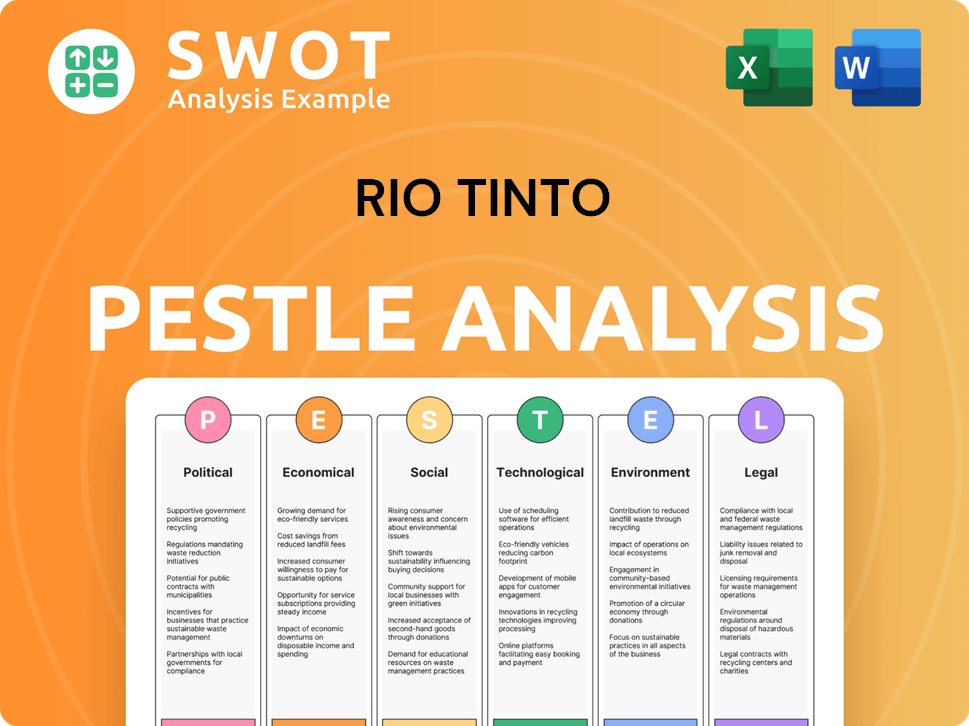
Which Strategic Decisions Have Shaped Rio Tinto’s Business Model?
The history of Rio Tinto is marked by significant milestones that have shaped its current operational and financial standing. Strategic acquisitions and divestments have been crucial in refining its portfolio. For instance, the company's sustained investment in its Pilbara iron ore operations has been a cornerstone of its success, with continuous upgrades and expansions to maintain its competitive edge in efficiency and scale.
Challenges such as fluctuating commodity prices, supply chain disruptions, and increasing regulatory scrutiny regarding environmental and social governance have required agile responses. The company has navigated these by focusing on operational resilience, cost management, and a commitment to sustainability. These strategic moves have been critical in maintaining its position in the global mining sector.
Rio Tinto's competitive advantages are multifaceted. Its extensive portfolio of world-class, long-life assets provides a significant barrier to entry for competitors. Economies of scale, particularly in iron ore, allow for lower per-unit production costs. Strong brand recognition and established relationships with global customers provide a stable demand base. Furthermore, the company's ongoing investment in technology, including automation and data analytics, enhances operational efficiency, safety, and environmental performance.
Key milestones include the expansion of iron ore operations in the Pilbara region of Western Australia. The company has continuously invested in technology to improve efficiency and reduce environmental impact. Strategic acquisitions and divestitures have reshaped Rio Tinto's portfolio over time.
Rio Tinto has focused on operational resilience and cost management to navigate market fluctuations. The company has increased its commitment to sustainability and environmental responsibility. Investments in critical minerals, such as lithium, are part of its strategic moves.
Rio Tinto's competitive advantage stems from its extensive portfolio of high-quality assets. Economies of scale and strong customer relationships provide a stable demand base. Ongoing investment in technology enhances operational efficiency and environmental performance.
Rio Tinto has faced challenges related to fluctuating commodity prices and supply chain disruptions. Increasing regulatory scrutiny regarding environmental and social governance requires agile responses. The company's focus on sustainability and operational resilience helps it navigate these challenges.
In 2024, Rio Tinto reported underlying earnings of $11.7 billion. The company's Pilbara iron ore production reached 324.6 million tonnes. Rio Tinto's focus on cost management led to significant operational improvements.
- Rio Tinto's iron ore shipments in 2024 were approximately 331.8 million tonnes.
- The company's capital expenditure in 2024 was around $7.1 billion.
- Rio Tinto's copper production in 2024 was 557,000 tonnes.
- The company is investing in renewable energy projects to reduce its carbon footprint.
Rio Tinto Business Model Canvas
- Complete 9-Block Business Model Canvas
- Effortlessly Communicate Your Business Strategy
- Investor-Ready BMC Format
- 100% Editable and Customizable
- Clear and Structured Layout
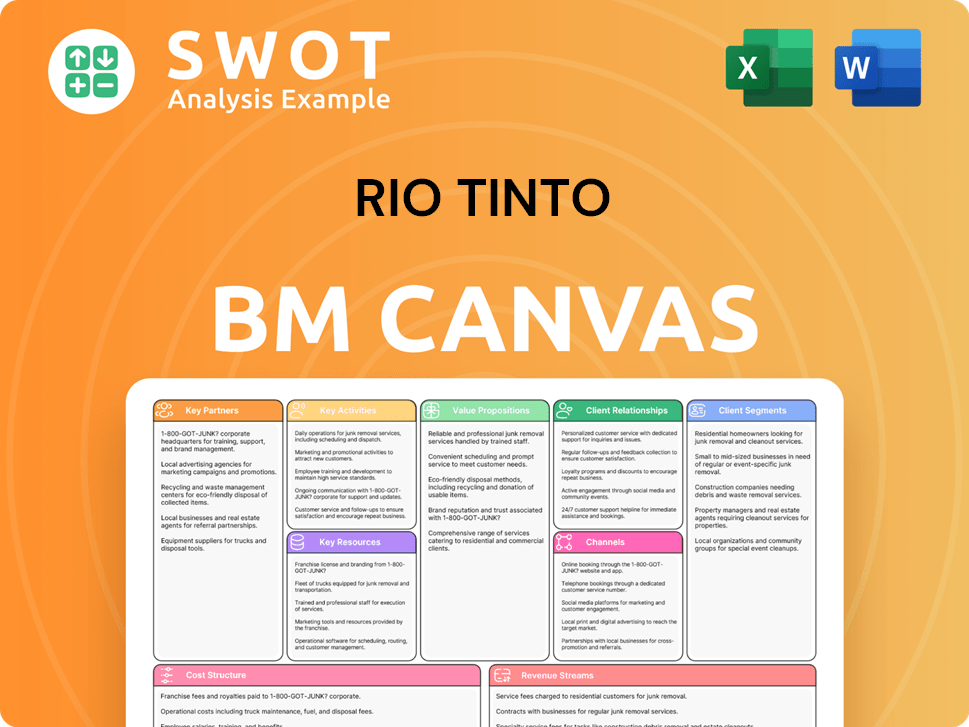
How Is Rio Tinto Positioning Itself for Continued Success?
Rio Tinto, a leading mining company, holds a prominent position in the global mining industry. Its significant market share in key commodities, especially iron ore, and its extensive global Rio Tinto operations, solidify its competitive advantage. The company's focus on reliable supply and quality products fosters strong customer loyalty, contributing to its robust market standing.
However, Rio Tinto faces various risks, including commodity price volatility, regulatory changes, and geopolitical instability. These factors can impact revenue, profitability, and supply chains. The evolving landscape, including environmental concerns and the emergence of new technologies, presents both challenges and opportunities for the company. Understanding these dynamics is crucial for evaluating Rio Tinto's performance and future prospects.
Rio Tinto is a global leader in the mining industry, particularly in iron ore. The company's wide geographical presence and diverse portfolio of resources, including aluminum, copper, and diamonds, strengthen its market position. Strong relationships with customers and a focus on operational efficiency contribute to its competitive advantage.
Rio Tinto faces risks such as commodity price fluctuations, which can significantly impact revenue. Regulatory changes, especially those related to environmental protection and carbon emissions, present ongoing challenges. Geopolitical instability and trade tensions can disrupt supply chains and market access. The emergence of new competitors also poses a long-term consideration.
Rio Tinto is strategically focused on future-facing commodities essential for the energy transition, such as copper and lithium. The company's innovation roadmap emphasizes decarbonization efforts and sustainable mining practices. Leadership is committed to operational excellence, disciplined capital allocation, and strong ESG performance to ensure long-term value creation.
The company is prioritizing growth in materials crucial for the energy transition. This includes investing in copper and aluminum, alongside exploring opportunities in lithium and other battery materials. Rio Tinto aims to sustain and expand its profitability by producing materials responsibly and efficiently, adapting to global demands and climate changes. You can learn more about the Target Market of Rio Tinto.
Rio Tinto's key initiatives include decarbonization efforts and investments in future-facing commodities. The company's focus on operational excellence and ESG performance is also crucial. Recent data shows Rio Tinto has been investing heavily in renewable energy projects to reduce its carbon footprint. In 2024, the company reported a strong financial performance, driven by high iron ore prices and increased demand for aluminum.
- Continued investment in copper and aluminum.
- Exploration of lithium and battery material ventures.
- Emphasis on decarbonization and green steel pathways.
- Commitment to operational excellence and ESG performance.
Rio Tinto Porter's Five Forces Analysis
- Covers All 5 Competitive Forces in Detail
- Structured for Consultants, Students, and Founders
- 100% Editable in Microsoft Word & Excel
- Instant Digital Download – Use Immediately
- Compatible with Mac & PC – Fully Unlocked
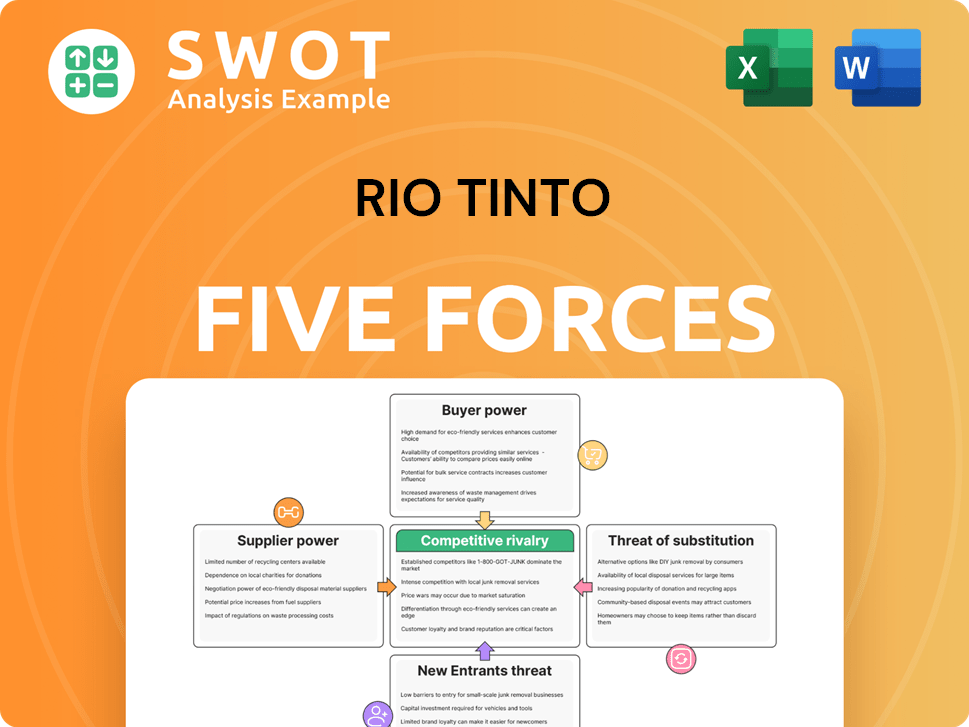
Related Blogs
- What are Mission Vision & Core Values of Rio Tinto Company?
- What is Competitive Landscape of Rio Tinto Company?
- What is Growth Strategy and Future Prospects of Rio Tinto Company?
- What is Sales and Marketing Strategy of Rio Tinto Company?
- What is Brief History of Rio Tinto Company?
- Who Owns Rio Tinto Company?
- What is Customer Demographics and Target Market of Rio Tinto Company?
Disclaimer
All information, articles, and product details provided on this website are for general informational and educational purposes only. We do not claim any ownership over, nor do we intend to infringe upon, any trademarks, copyrights, logos, brand names, or other intellectual property mentioned or depicted on this site. Such intellectual property remains the property of its respective owners, and any references here are made solely for identification or informational purposes, without implying any affiliation, endorsement, or partnership.
We make no representations or warranties, express or implied, regarding the accuracy, completeness, or suitability of any content or products presented. Nothing on this website should be construed as legal, tax, investment, financial, medical, or other professional advice. In addition, no part of this site—including articles or product references—constitutes a solicitation, recommendation, endorsement, advertisement, or offer to buy or sell any securities, franchises, or other financial instruments, particularly in jurisdictions where such activity would be unlawful.
All content is of a general nature and may not address the specific circumstances of any individual or entity. It is not a substitute for professional advice or services. Any actions you take based on the information provided here are strictly at your own risk. You accept full responsibility for any decisions or outcomes arising from your use of this website and agree to release us from any liability in connection with your use of, or reliance upon, the content or products found herein.